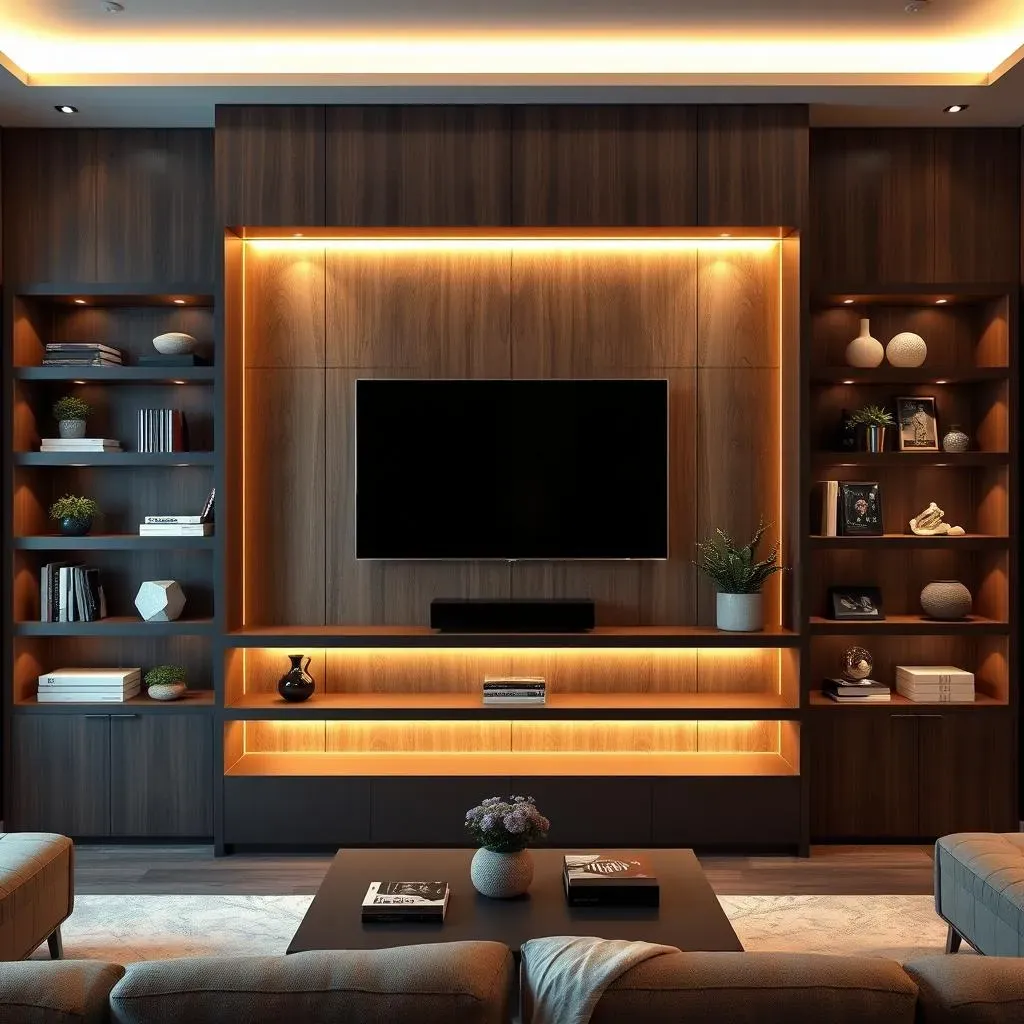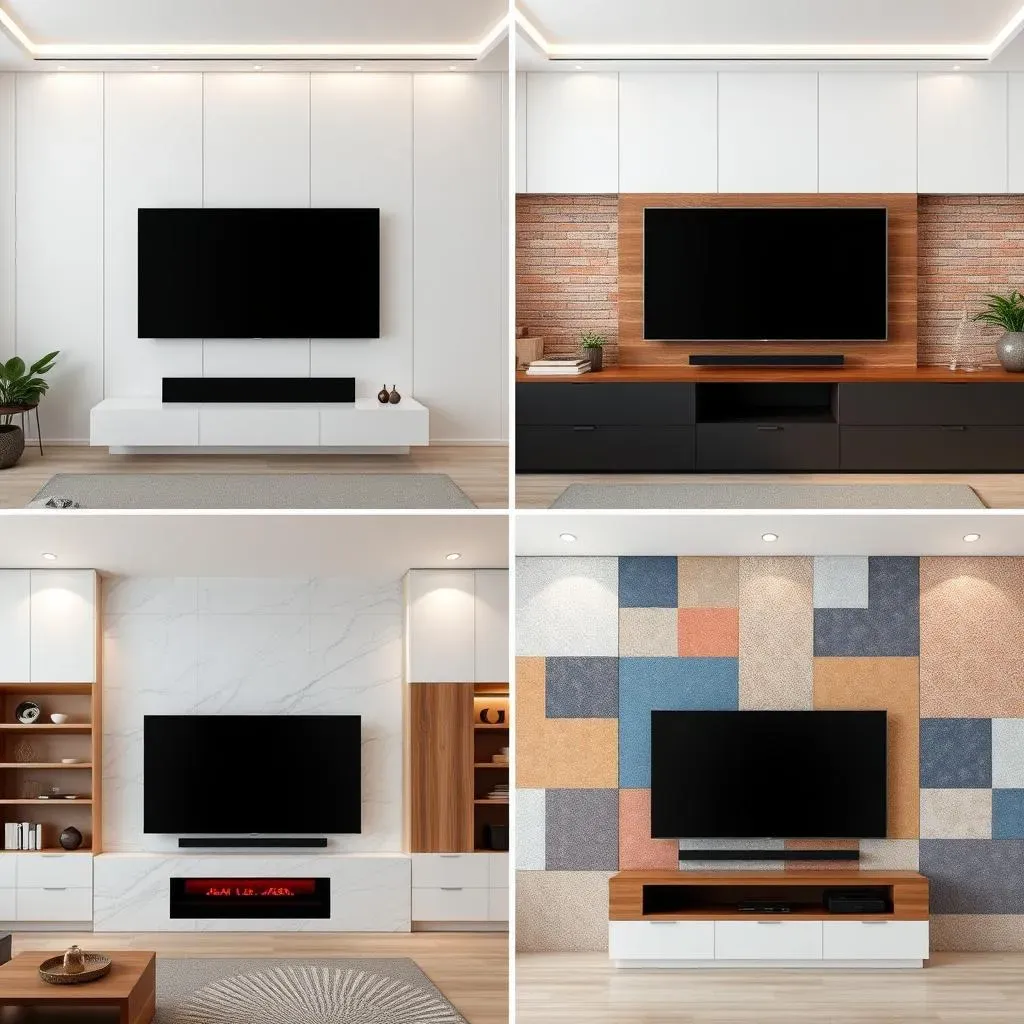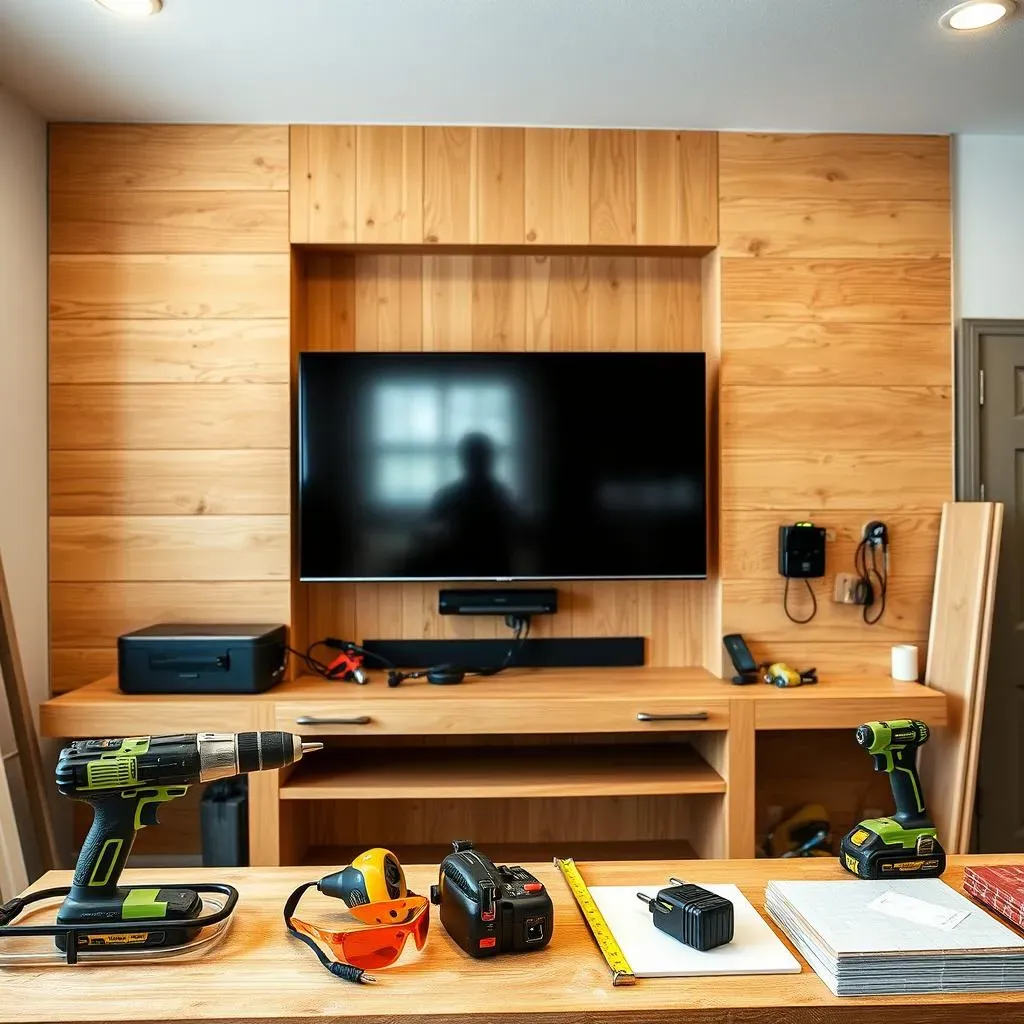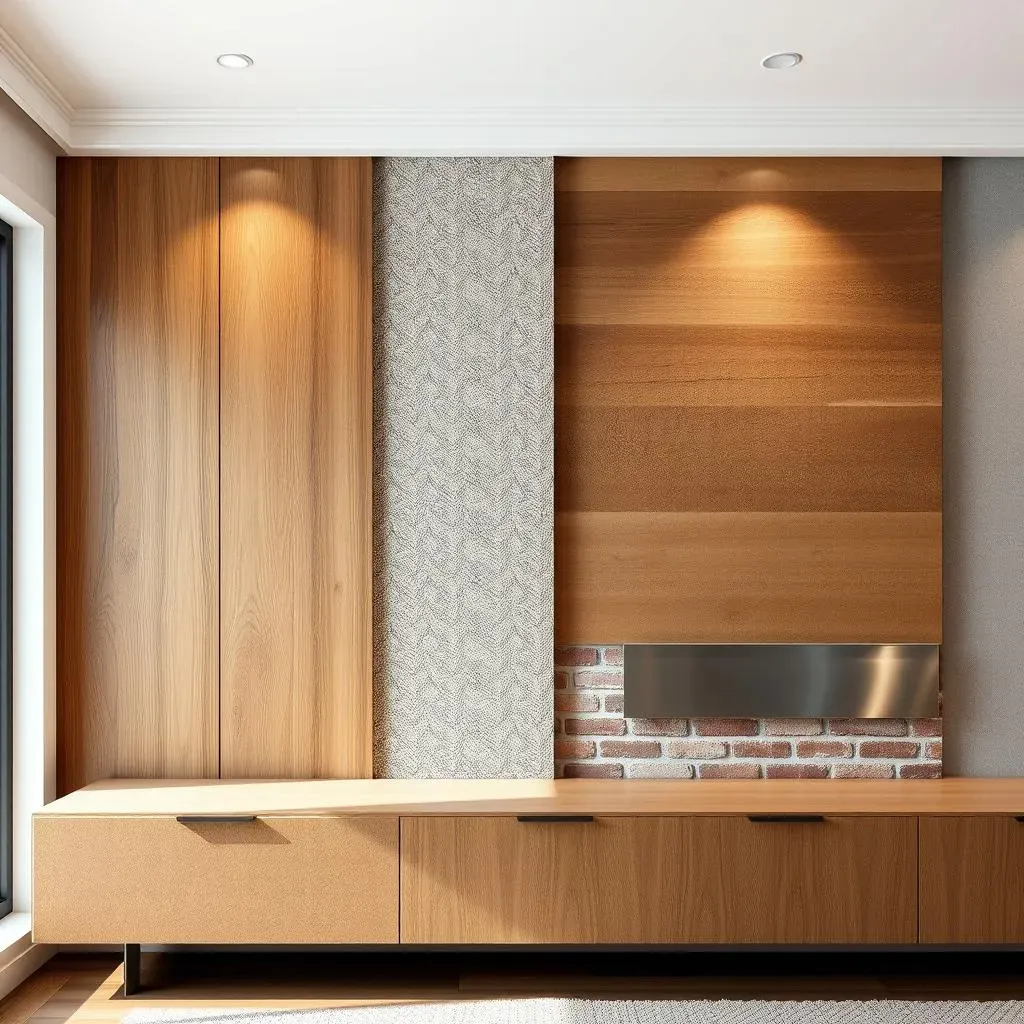Table of Contents
Tired of that blank space staring back at you every time you settle in for movie night? A media accent wall could be the game-changer your living room (or any entertainment space) desperately needs. It's more than just a place to hang your TV; it's an opportunity to inject personality, style, and a serious dose of "wow" into your home. In this article, we're diving deep into the world of media accent walls. From understanding why they're so effective at transforming a room, to exploring a range of design ideas that suit every taste and budget, we've got you covered. Thinking of getting hands-on? We'll walk you through a step-by-step DIY guide, and even help you choose the perfect materials to bring your vision to life. Whether you're a seasoned DIY enthusiast or just starting to explore your design potential, get ready to unlock the secrets to creating a media accent wall that's not only functional but also a true reflection of your unique style. Let's get started!
Why a Media Accent Wall is a MustHave

Why a Media Accent Wall is a MustHave
Let's be real, the days of just plopping a TV on a stand are long gone. A media accent wall is a game-changer because it instantly elevates the entire vibe of your space. It's not just about hiding wires or providing a backdrop for your screen; it's about creating a focal point that draws the eye and ties the room together. Think of it as the statement piece that anchors your entertainment area, adding depth, texture, and a touch of personality that a plain wall simply can't offer. It's the difference between a functional room and a thoughtfully designed living space.
But the benefits go beyond aesthetics. A well-designed media accent wall can also be incredibly practical. It can provide clever storage solutions, conceal unsightly cables, and even improve your viewing experience by reducing glare and creating a more immersive environment. Plus, it's a fantastic way to showcase your personal style, whether you're into sleek minimalism, rustic charm, or bold, modern designs. It's like giving your TV a stylish stage to perform on, and who doesn't want that?
Still not convinced? Consider the impact on resale value. A thoughtfully designed and well-executed media accent wall can be a major selling point, adding a touch of sophistication and modern appeal that potential buyers will definitely notice. In a world where first impressions matter, a media accent wall can be the detail that sets your home apart.
Creative Media Wall Ideas for Every Style

Creative Media Wall Ideas for Every Style
let's brainstorm some seriously cool media accent wall ideas! The best part? There's a style for everyone, whether you're a minimalist at heart or someone who loves a bit of bold drama. If you are into the sleek and modern vibe, consider a floating media console with integrated LED lighting and a smooth, matte finish. This is about clean lines and hidden storage, creating a clutter-free zone that's both functional and visually appealing. On the other hand, if you're drawn to the warmth and character of rustic design, think about incorporating reclaimed wood panels or a brick veneer to add texture and a touch of vintage charm. The key is to find a design that complements your existing decor and reflects your unique personality.
For those who love a touch of luxury, a marble or stone accent wall can create a stunning focal point. Imagine a beautifully veined marble backdrop with a built-in fireplace – talk about cozy and chic! Or, if you're feeling adventurous, why not try a geometric pattern using different colors and textures? This can add a playful and contemporary edge to your space. Don't be afraid to mix and match materials to create a truly unique look. The possibilities are endless, and the goal is to create a media accent wall that's not only functional but also a work of art.
Style | Materials | Key Features |
|---|---|---|
Modern Minimalist | Smooth panels, LED lighting | Clean lines, hidden storage |
Rustic Charm | Reclaimed wood, brick veneer | Texture, vintage appeal |
Luxurious | Marble, stone | Elegant, sophisticated |
Geometric | Various colors and textures | Playful, contemporary |
DIY Media Accent Wall: A StepbyStep Guide

DIY Media Accent Wall: A StepbyStep Guide
Planning Your Project: Design and Measurements
Alright, ready to roll up your sleeves? First things first: planning is key. Before you even think about picking up a hammer, you need a solid design. Sketch out your vision. Consider the size of your TV, the dimensions of your wall, and the overall style you're going for. Don't skip this step! A little planning goes a long way in preventing headaches later. Measure your wall precisely – twice! – and mark the locations of outlets, studs, and any other obstacles. This will help you avoid costly mistakes and ensure a smooth installation process. Think about storage too. Do you want shelves, cabinets, or a combination of both? Plan it all out on paper first.
Next, gather your inspiration. Pinterest, home decor magazines, and even your favorite design blogs are great resources for finding ideas. Save the images that resonate with you and identify the elements you love. Are you drawn to clean lines, rustic textures, or bold colors? Once you have a clear sense of your aesthetic, you can start to refine your design and choose the materials that best fit your vision. Don't be afraid to get creative and put your own spin on things. This is your chance to create a media accent wall that's truly unique and reflects your personal style. Also, think about the viewing angle from your seating area. You want to ensure that your TV is positioned at a comfortable height and distance for optimal viewing.
Tools and Materials: Getting Equipped
design locked down? Time to gather your arsenal! This is where having a detailed plan really pays off. Make a comprehensive list of all the tools and materials you'll need, and double-check it before you head to the store. Nothing's worse than getting halfway through a project and realizing you're missing a crucial component. Essential tools include a measuring tape, level, stud finder, drill, saw (circular or miter saw recommended), sandpaper, and safety glasses. Don't skimp on the safety gear – protecting your eyes is crucial when working with power tools.
As for materials, the possibilities are endless! Wood panels, shiplap, MDF, brick veneer, stone tiles – the choice is yours. Consider the overall aesthetic you're aiming for and choose materials that complement your existing decor. Don't forget to factor in the cost. Some materials are more expensive than others, so be sure to set a budget and stick to it. Other essential materials include screws, nails, wood glue, paint or stain, and any necessary hardware for mounting shelves or cabinets. If you're planning to incorporate lighting, make sure you have the appropriate wiring and fixtures. And remember, always buy a little extra material to account for mistakes or unexpected changes.
Tool/Material | Purpose | Notes |
|---|---|---|
Measuring Tape | Accurate measurements | Get a good quality one! |
Stud Finder | Locating wall studs | Essential for secure mounting |
Drill | Screwing and drilling | Cordless is convenient |
Safety Glasses | Eye protection | Always wear them! |
Choosing the Right Materials for Your Media Accent Wall

Choosing the Right Materials for Your Media Accent Wall
Aesthetic vs. Practicality: Finding the Balance
so you've got the design down, but now comes the real test: choosing the right materials. It's not just about what looks good; it's about finding that sweet spot where aesthetics meet practicality. For example, that gorgeous reclaimed wood might look incredible, but is it treated to prevent warping or insect infestations? That sleek marble panel might scream luxury, but can your wall support the weight? These are the questions you need to be asking yourself.
Think about your lifestyle, too. Do you have kids or pets? If so, you'll want to choose materials that are durable and easy to clean. A delicate fabric-covered wall might look stunning, but it's probably not the best choice for a high-traffic area. Similarly, if you live in a humid climate, you'll need to consider materials that are resistant to moisture. It's all about striking a balance between the look you want and the functionality you need.
Material Breakdown: Pros, Cons, and Costs
Let's break down some popular material choices, shall we? First up, we've got wood. Wood panels, shiplap, and even good ol' plywood are all great options for adding warmth and texture. They're relatively easy to work with, and you can customize them with paint, stain, or even decorative moldings. However, wood can be susceptible to moisture damage, so it's important to seal it properly. Next, there's MDF (Medium Density Fiberboard). MDF is a budget-friendly option that's smooth, consistent, and easy to paint. But it's not as durable as solid wood and can be prone to swelling if it gets wet. Then, we have stone and brick. These materials add a touch of natural elegance and are incredibly durable. But they can be heavy and require specialized installation.
And don't forget about alternatives like textured wallpaper, fabric panels, and even metal accents. Textured wallpaper can mimic the look of more expensive materials at a fraction of the cost, while fabric panels can add a soft, luxurious touch. Metal accents, like brushed aluminum or stainless steel, can create a sleek, modern vibe. The key is to weigh the pros and cons of each material and choose the ones that best fit your budget, style, and lifestyle. Consider the long-term maintenance required for each material. Some materials may require more upkeep than others, so factor that into your decision-making process.
Material | Pros | Cons | Approx. Cost (per sq ft) |
|---|---|---|---|
Wood Panels | Warm, customizable, easy to work with | Susceptible to moisture | $5 - $15 |
MDF | Budget-friendly, smooth, paintable | Not as durable as wood, prone to swelling | $3 - $8 |
Stone/Brick | Durable, elegant, natural | Heavy, requires specialized installation | $10 - $30 |
Textured Wallpaper | Easy to install, various patterns | Not as durable | $1 - $5 |
Installation Considerations: DIY vs. Professional
you've got your materials, now how are you going to actually put this thing together? This is where you need to decide whether you're going the DIY route or hiring a professional. If you're a seasoned DIYer with a well-equipped workshop and plenty of experience, then tackling the installation yourself might be a rewarding challenge. Just be sure to do your research, follow safety precautions, and take your time. Rushing through the process can lead to mistakes and a less-than-perfect result.
On the other hand, if you're not comfortable working with power tools or you're dealing with heavy or complex materials, then hiring a professional installer might be the best option. A professional will have the expertise and equipment to ensure a safe and precise installation, and they can also help you troubleshoot any unexpected problems that may arise. Plus, they'll be able to handle tasks like electrical wiring and plumbing, which are best left to the experts. Ultimately, the decision comes down to your skill level, budget, and the complexity of your project.
Elevate Your Entertainment Space with a Media Accent Wall
A media accent wall is more than just a backdrop for your TV; it's a statement piece that can transform the entire ambiance of your room. From sleek, modern designs to rustic, cozy aesthetics, the possibilities are endless. By carefully considering your personal style, the existing décor, and the available space, you can create a media accent wall that not only enhances your viewing experience but also adds value and character to your home. So, go ahead, get inspired, and start planning your own media accent wall masterpiece today!
